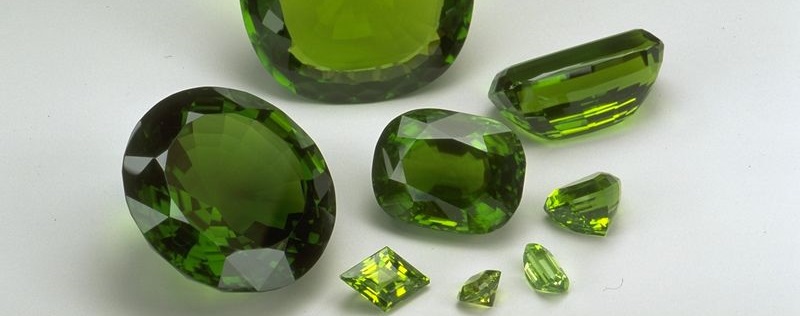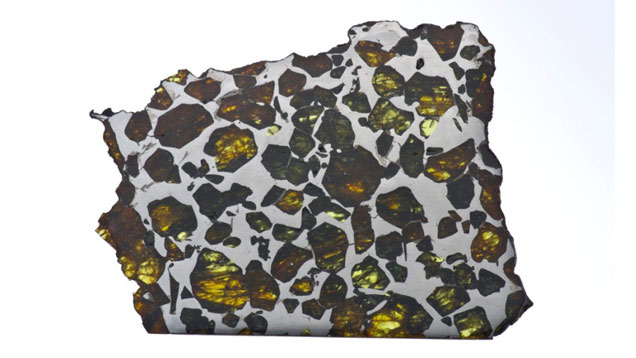More on Peridot, the August Birthstone
The origin of the name peridot is uncertain. But there are three etymologies that are related to this beautiful green stone:
- Pedoretès – Latin – means “a kind of opal”
- Peridona – Greek – means something like “to give richness”
- Faridat – Arabic – means “gem”
 It is one of the few gemstones that come in only one color, green. But in a wide range of natural shades of lime, yellowish green, olive green or medium dark green. The favored color is the vivid green color with just a slight hint of gold.
It is one of the few gemstones that come in only one color, green. But in a wide range of natural shades of lime, yellowish green, olive green or medium dark green. The favored color is the vivid green color with just a slight hint of gold.
This favored color is caused by very fine traces of iron. From a chemical point of view, peridot is an iron magnesium silicate and the intensity of the color depends on the amount of iron actually present. Peridot is not particularly hard, only 6.5 to 7 on the Mohs scale, but it is easy to look after and fairly robust.
It is also a very old gemstone which has become very popular again today.
The Ancient Peridot
Its ancient remnants can be found in Egyptian jewelry from early 1300 B.C.; the stones used at that time came from a deposit on a small volcanic island in the Red Sea, some 45 miles off the Egyptian coast at Aswan, which was not rediscovered until about 1900s and has, meanwhile, been exhausted for quite some time. The Egyptians called it the “gem of the sun.”
The ancient Romans too were fond of this gemstone and esteemed its radiant green shine, which does not change even in artificial light. For that reason they nicknamed it the ’emerald of the evening’. Peridot is also found in Europe in medieval churches, where it adorns many a treasure, for example one of the shrines in Cologne Cathedral. During the baroque period, the rich green gemstone once again enjoyed a brief heyday, and then it somehow faded into oblivion.
Peridot is a gemstone that forms deep inside the Earth and is brought to the surface by volcanoes, it symbolizes the tears of Pele, the goddess of fire and volcanoes, in Hawaii. It was also said to host magical powers and healing properties to protect against nightmares and to bring the wearer power, influence, and a wonderful year.
The Modern Peridot
Though it has historical appearances, peridot is also a thoroughly modern gemstone. In 1990s, the peridot became a big sensation at gemstone fairs all round the world because rich deposits of the finest peridots had been discovered in Pakistan. They have deposits of an incomparably beautiful color and transparency which succeeds in giving a good polish to the image of this beautiful gemstone.
The gems from this region can only be mined during the summer months due to intense climatic condition. Unusually large, fine crystals and fragments came here and the stones were finer than anything that had ever been seen before and they are known as ‘Kashmir peridots’, following the famous Kashmir sapphires. Creative gemstone cutters have succeeded in cutting some fascinatingly beautiful one-off stones of more than 100 carats from some of the large, fine, clear crystals with their magnificent rich green shine.
In 2005, peridot was found in comet dust brought back from the Stardust robotic space probe. And until now, it is the only gemstone that can be found on meteorites.

Esquel meteorite reveals a kaleidoscope of peridot crystals from outer space | Photo from GIA
The Cut
Speaking of the cut…peridot is cut in accordance with its crystal shape, mostly faceted or in classical table cuts, or round, antique, as an octahedron or oval. Smaller crystals are cut into standardized series stones, larger ones into imaginative one-offs. Cabochons are made if the material contains more inclusions, for the domed cut brings out the fine silky shine of the inclusions to their best.
However, every cutter knows that this gemstone is not easy to work with. The raw crystals can be very tricky and may crack easily. But once the cutter has succeeded in removing the coarser inclusions, the peridot is a precious stone that is durable for everyday use and does not call for any special care.
The Jewelry
Peridot is increasing in its popularity in the world of fashion. It is seen as an adornment for all kinds of jewelry, may it be a ring, pendant, or earrings.
Thanks to the rich finds in Pakistan and Afghanistan, there is enough raw material on the market to cater this ongoing trend – fitting one’s taste and budget. Large, transparent stones of an intense color are rare and correspondingly expensive; peridot cat’s eyes and star peridot are particularly rare and precious as well. But there are also attractive smaller gems available for jewelry at all price points.










